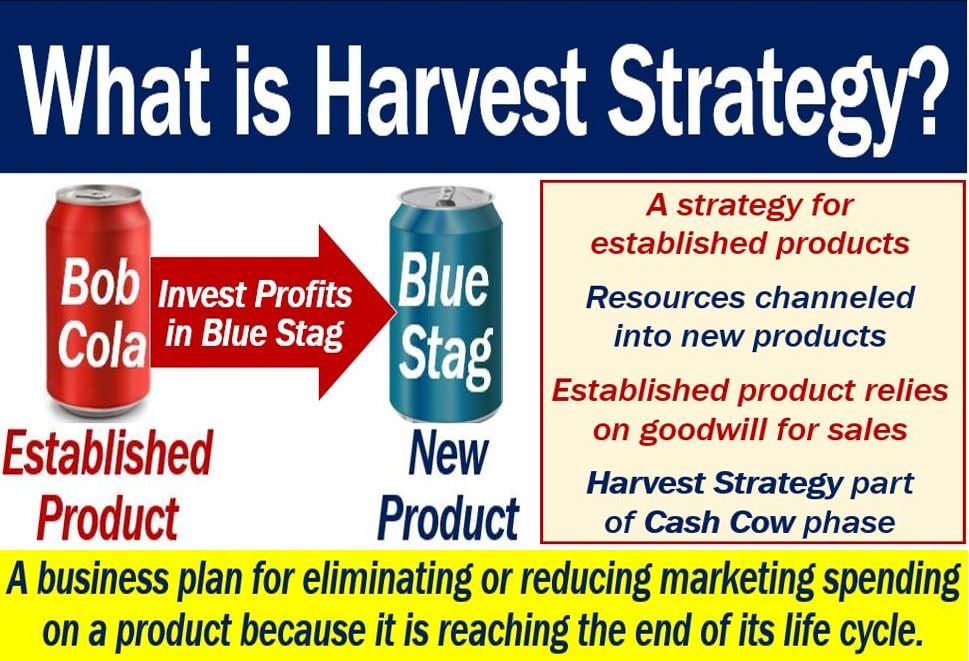Harvest strategy – definition and meaning
A Harvest Strategy or Harvesting Strategy is a business plan for either canceling or reducing marketing spending on a product. The management has decided that it would cost too much to boost sales. In other words, they could not justify the expense after considering likely future revenues from the product.
The term ‘harvest strategy’ may also refer to a brand or line of business.
Marketing executives choose a harvesting strategy when a product has reached the end of its life cycle. They aim to extract maximum profit from any remaining sales.
Put simply; the product sells thanks to its goodwill and nothing else. Goodwill refers to the established reputation of a product.
MbaSkool.com says the following regarding a harvest strategy:
“When the revenue made by additional investment would not overcome the expense, all marketing investment in a particular business line is reduced or eliminated, as sales revenue falls below a cutoff point.”

Harvest strategy – cash cow
Companies use a harvesting strategy when a product has reached the cash cow stage. Cash cow refers to a product that makes a profit in a mature market and does not need heavy reinvestment.
It is unlikely that sales will increase even if the company invests further in the product.
There would be a much better return-on-investment if profits were spent elsewhere in the company.
When implementing a harvest strategy, the company has three options:
- Eliminate or reduce all capital spending on the product. In other words, keep using existing equipment until it no longer works.
- Reduce or eliminate marketing and advertising expenditure. New sales will rely on brand loyalty.
- Eliminate or reduce operating expenses. In other words, only approve expenditure when the return on investment is very high.
A harvest strategy may also reflect a company’s environmentally sustainable approach by reducing the resource intensity of products that are phasing out of the market.
Harvest strategy – telecommunications
A Money-Zine article cites the telecommunications sector. As more areas across America have wireless signals, the need for a landline telephone declines.
Telecom companies continue supporting landline technology. However, they do not rebuild wired networks when storms, for example, destroy them. They focus their expenditure on expanding wireless coverage.
In most cases, businesses use the profits from their ‘mature’ brands to fund the development of new ones. They may also invest profits in existing products that they believe have good growth potential.
By reallocating resources from mature products, companies can capitalize on the opportunity to innovate and gain a competitive edge in emerging markets.
Harvest strategy – equity investments
In the world of equity investment, the term has a different meaning. It refers to a proposed plan for private equity investors or venture capitalists. The aim is to get the most profit from their investment.
For equity investors, floating a company, i.e., launching an IPO, is an example of a harvest strategy. IPO stands for Initial Public Offering. An IPO occurs when the shares of a company become available for the public to buy for the first time. Investors can buy and sell that company’s shares on a stock exchange.
Another example is to sell the company in which the investor has a stake.
“Harvest strategy” – vocabulary and examples
There are many terms in English closely related to “harvest strategy,” especially compound nouns. A compound noun, such as “harvest strategy planning,” is a term consisting of at least two words. Let’s take a look at some of them, their meanings, and how we can use them in a sentence:
-
Harvest Strategy Implementation
The process of putting a harvest strategy into action within a company.
Example: “The firm’s harvest strategy implementation involved scaling back on production while maximizing the remaining inventory turnover.”
-
Harvest Strategy Planning
The phase where a company develops a harvest strategy, considering the product’s lifecycle and market conditions.
Example: “During the harvest strategy planning meeting, the team decided to discontinue further R&D investment in the aging product line.”
-
Harvest Strategy Assessment
An evaluation to determine the effectiveness of a harvest strategy in meeting financial goals.
Example: “An annual harvest strategy assessment is conducted to ensure that the diminishing returns from the product still align with the company’s profit objectives.”
-
Harvest Strategy Metrics
The set of quantitative measures used to evaluate the performance of a harvest strategy.
Example: “The board reviewed the harvest strategy metrics to decide whether to continue the product line or divest.”
-
Harvest Strategy Decision
The conclusion reached by a company to either initiate or conclude a harvest strategy for a product.
Example: “The management’s harvest strategy decision was influenced by the sharp decline in the product’s market share.”
-
Harvest Strategy Timeline
The schedule that outlines the duration and key milestones of a harvest strategy from inception to completion.
Example: “The project manager created a detailed harvest strategy timeline to ensure a smooth transition during the product phase-out period.”
-
Harvest Strategy Analysis
The in-depth study and examination of a harvest strategy to determine its potential outcomes and impacts.
Example: “A thorough harvest strategy analysis revealed that continuing with minimal support could still yield a modest profit margin for the next two years.”
Video – What is a Harvest Strategy?
This video, from our YouTube partner channel – Marketing Business Network – explains what a ‘Harvest Strategy’ is using simple and easy-to-understand language and examples.

